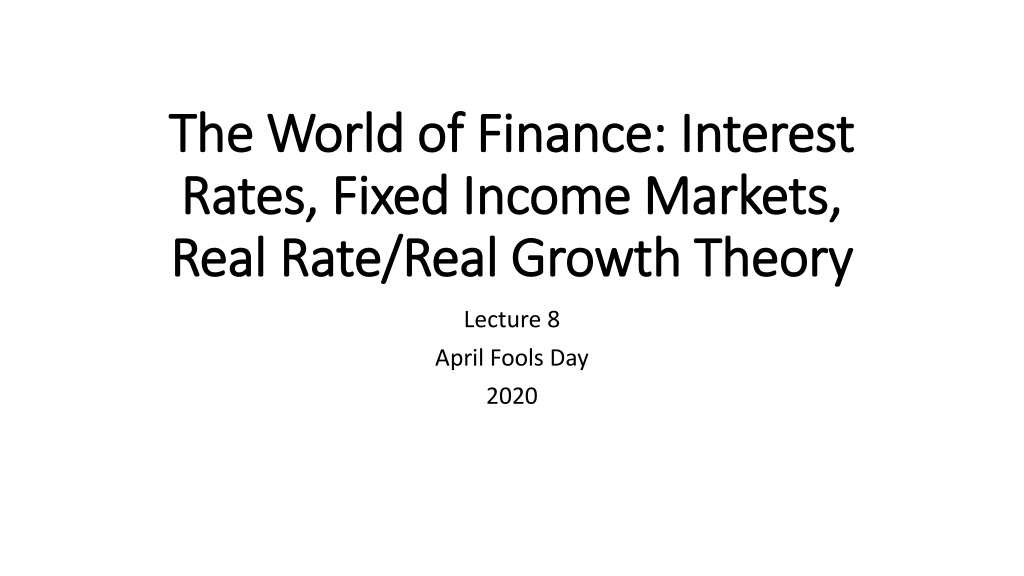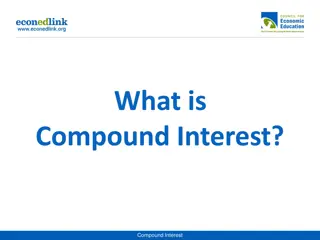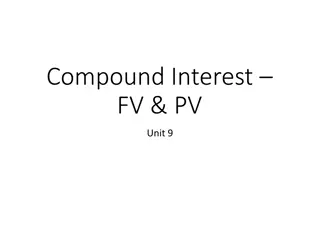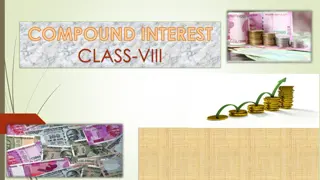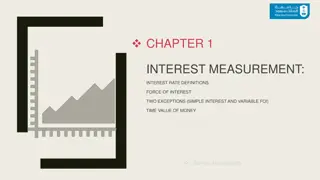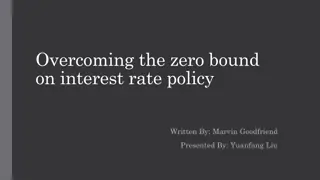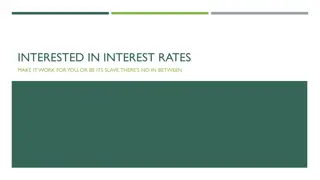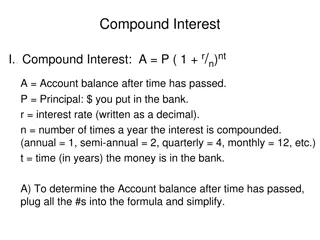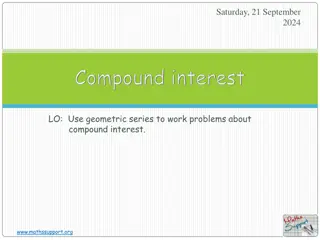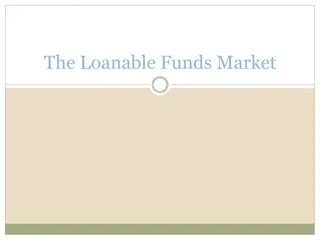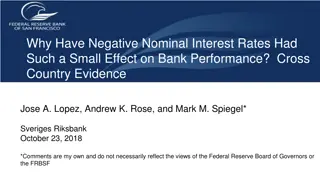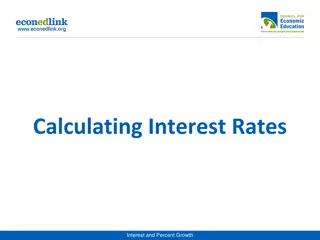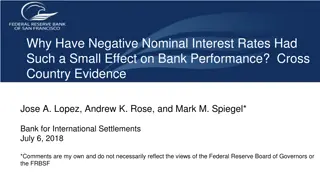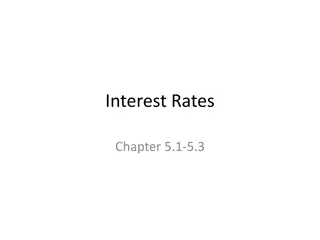Understanding Interest Rates and Real Growth in Finance
Explore the dynamics of interest rates, real growth theory, inflation's impact on purchasing power, the Fisher equation, and the theory of interest by J.R. Hicks. Learn about ex-ante vs. ex-post real interest rates and the term premium in fixed income markets. Understand how credit spreads and default risk premiums affect the financial system.
Download Presentation

Please find below an Image/Link to download the presentation.
The content on the website is provided AS IS for your information and personal use only. It may not be sold, licensed, or shared on other websites without obtaining consent from the author. Download presentation by click this link. If you encounter any issues during the download, it is possible that the publisher has removed the file from their server.
E N D
Presentation Transcript
The World of Finance: Interest The World of Finance: Interest Rates, Fixed Income Markets, Rates, Fixed Income Markets, Real Rate/Real Growth Theory Real Rate/Real Growth Theory Lecture 8 April Fools Day 2020
A quick Aside: Real Interest Rates Ernie has $1,000, wants to buy a Moped. Bert asks Ernie to lend him the $1,000. I ll repay the $1,000 plus $50 in interest. Ernie decides he can get a helmet, if he waits. So Ernie lends Bert $1,000 for one year.
Inflation Can Destroy Purchasing Power One year later Ernie collects $1050 He goes to buy he Moped. But its now priced at $1,100 Ernie s lament: I got less than nothing for lending to Bert! The moral: when you lend money you want to be paid real interest.
The Fisher equation i = r + I Interest rate = real rate + inflation rate(expected)
Ex-Ante vs. Ex-Post Real Interest Rates ante= = - -0.8% Ex Ex- -ante today: 10yr=0.6% // ante today: 10yr=0.6% // e e=1.4% // Real =1.4% // Realex ex- -ante 0.8% 10-Year 12-Month Actual Ex-Ante Ex-Post Yield Core CPI Real Real 12-70 6.4 4.6 7.9 1.8 -1.5 12-80 12.8 9.6 4.8 3.2 8 3-10 3.8 1.3 ??? 1.5 ???
A Theory of Interest. J. R. Hicks The essential characteristic of a loan transaction is that its execution is divided in time. The money rates of interest paid for different loans at the same date differ from one another for two main reasons: (I) because of differences in the length of time for which loans are to run (2) because of differences in the risk of default by the borrower.
duration duration: term premium on average, 10 year yield is 1.07% above the 2-year yield
Default: Risk premium Default: Risk premium Credit Spreads: How the Financial System Amplifies the Boom/Bust Cycle Credit Spreads: How the Financial System Amplifies the Boom/Bust Cycle (Moody s Baa Yield) minus (U.S. treasury 10 (Moody s Baa Yield) minus (U.S. treasury 10- -year yield) year yield) Credit spreads show us the risk premium investors demand, to lend to companies that have some chance of defaulting Credit spreads show us the risk premium investors demand, to lend to companies that have some chance of defaulting
EFFICIENT MARKET HYPOTHESIS EFFICIENT MARKET HYPOTHESIS Day to day we depend on the notion of informed investors repricing assets, so that they Day to day we depend on the notion of informed investors repricing assets, so that they reflect all new information and make sense versus one another. reflect all new information and make sense versus one another. (look at today s cash versus future price for oil) (look at today s cash versus future price for oil)
How do we relate the real interest rates, r to real growth rates, y? Samuelson s overlapping generations model: TOTAL PRODUCTION YEAR YEAR COHORT COHORT COHORT COHORT A B 100 100 100 0 100 0 C D 1 2 3 4 100 200 200 200 100 100 100 TOTAL COHORT COHORT COHORT COHORT COHORT A B C CONSUMPTION D E YEAR 1 2 3 4 5 100 200 200 200 200 100 50 50 150 0 50 150 0 50 150 0 150
We now agree that optimal smoothing, in a world where no one We now agree that optimal smoothing, in a world where no one is impatient, still results in a painful lifetime distribution of is impatient, still results in a painful lifetime distribution of consumption: GORGE EARLY, STARVE LATER consumption: GORGE EARLY, STARVE LATER TOTAL CONS. COHORT COHORT COHORT COHORT COHORT COHORT COHORT COHORT COHORT COHORT COHORT A B C D E F G H I J K YEAR 1 2 3 4 5 6 100 200 200 200 200 200 100 58 42 142 29.0 29.0 129.0 35.5 35.5 135.5 32.3 32.3 132.3 33.9 33.9 133.9 33.1 33.1 133.1 33.5 33.5 133.5 33.3 33.3 133.3 33.4 33.4 133.4 33.3 133.3
Now we introduce money. Money allows us to save. The savings Now we introduce money. Money allows us to save. The savings allow us to trade with the as yet unborn generation: allow us to trade with the as yet unborn generation: We will inject two doses of money into this economy. We will impose a specific consumption pattern for gens A and B In period 1, generation A is given $5.00 In period 2, both generation A and B are given $5.00 In years 1 and 2, Generation A consumes all of its production, and keeps its $10. In year 2, Generation B consumes all of its production, and keeps its $5.00 In period 3, money begins to change hands.
What are the circumstances in place, in period 3? Gen A has $10, will produce no output, will spend all $10.00. Gen B has $5, will produce 100 units of output, will save the $5.00 Gen C has $0.00, will produce 100 units.
In period 3, what is the optimal money/goods In period 3, what is the optimal money/goods trading strategy for generations A/B/C? trading strategy for generations A/B/C? The young cohort (C) receives $5 from the old, for 33.3 chocolates. Cohort C, therefore consumes 66.7 units, and saves $5. The middle cohort (B) receives $5 from the old, for 33.3 chocolates. Cohort B, therefore consumes 66.7 units, and now has $10.00 saved. The oldsters (A) spend all their money, they consume 66.7 chocolates in their last year of life. Now $10 buys you 66.7 units, the oldsters always have $10, and the system has perfectly smoothed consumption thanks to the oldsters newfound ability to trade with the newly arrived producing generation.
Smoothed Consumption, with Climbing Productivity and a Rising Labor Force: Smoothed Consumption, with Climbing Productivity and a Rising Labor Force: Population grows 5% per year. Population grows 5% per year. Each new cohort is 5% more productive. Each new cohort is 5% more productive. Output, after year 1, therefore, grows 10% per year: Output, after year 1, therefore, grows 10% per year: TOTAL PRODUCTION COHORT COHORT COHORT COHORT A B 100 100 110 0 110 0 C D 100 210 231 254 121 121 133
Once again, we inject two doses of money, totaling $10/A, $5.70/B Period 3, A buys 33 from B for $4.30, 44 from C, for $5.70 Now B has $10 and C has $5.70 A B C production consump. 100 100 0 saving 5 10 0 prod. consump. saving prod. consump. saving 100 100 77 110 110 77 5.7 10 121 77 5.7
Recall, however, that output rises 10%/period. Period 4, total funds, $15, will buy more output. In period 3: CA buys 33 chocolates from CB for $4.30 CA buys 44 chocolates from CC for $5.70 Note: 1 chocolate = 13 cents In period 4: CB buys 36.3 chocolates from CC for $4.30 CB buys 48.3 chocolates from CD for $5.70 Note: 1 chocolate = 12 cents In period 5: CC buys 93 chocolates from CD and CE for $10.0 Note: 1 chocolate = 11 cents
We can now calculate this economys REAL INTEREST RATE. We can now calculate this economy s REAL INTEREST RATE. Period to period, it cost you 10% more in output, to secure 1$. Period to period, it cost you 10% more in output, to secure 1$. Thus the real interest rate IS the economy s real growth rate. Thus the real interest rate IS the economy s real growth rate. output purchased Dollars spent dollar price per chocolate output needed for 1$ $7.70 $8.46 $9.30 increase in amount of period 3 period 4 period 5 77 84.6 93 $10 $10 $10 10% 10%
U.S. Treasury Inflation protected notes(TIPS) Falling real borrowing rates:
Credit spreads provide us with market expectations of default probabilities: Loan: T-Note Corp loans We now solve for X: 1.08(10,000)(100-X) - 1.08(10,000)(100) - ((1.08)(10,000)X + X(5000)) = 1,0870,000-1,030,000 = 15,800X X = 3.1 Principal $1,000,000 $1,000,000 Interest rate lump-sum payment # of Defaults 3% $1,030,000 8% $1,030,000 zero X X(5,000) = 1.03(1,000,000) 1,030,000
Real rate demanded of junk borrowers 2.35%, 2/15/20. 8%, 3/25/20
